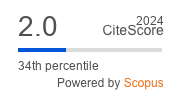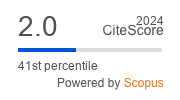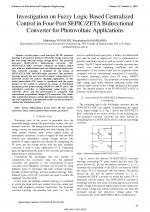| 1/2016 - 8 |
Investigation on Fuzzy Logic Based Centralized Control in Four-Port SEPIC/ZETA Bidirectional Converter for Photovoltaic ApplicationsVENMATHI, M. |
| Extra paper information in |
| Click to see author's profile in |
| Download PDF |
Author keywords
bidirectional power flow, DC-DC power converters, fuzzy control, photovoltaic systems, pi control
References keywords
power(24), electronics(18), systems(9), converter(9), port(8), converters(8), chen(7), input(6), renewable(5), photovoltaic(5)
Blue keywords are present in both the references section and the paper title.
About this article
Date of Publication: 2016-02-28
Volume 16, Issue 1, Year 2016, On page(s): 53 - 60
ISSN: 1582-7445, e-ISSN: 1844-7600
Digital Object Identifier: 10.4316/AECE.2016.01008
Web of Science Accession Number: 000376995400008
SCOPUS ID: 84960084357
Abstract
In this paper, a new four-port DC-DC converter topology is proposed to interface renewable energy sources and the load along with the energy storage device. The proposed four-port SEPIC/ZETA bidirectional converter (FP-SEPIC/ZETA BDC) converter comprises an isolated output port with two unidirectional and one bidirectional input ports. This converter topology is obtained by the fusion of SEPIC/ZETA BDC and full-bridge converter. This converter topology ensures the non-reversal of output voltage hence it is preferred mostly for battery charging applications. In this work, photovoltaic (PV) source is considered and the power balance in the system is achieved by means of distributed maximum power point tracking (DMPPT) in the PV ports. The centralized controller is implemented using fuzzy logic controller (FLC) and the performance is compared with conventional proportional integral (PI) controller. The results offer useful information to obtain the desired output under line and load regulations. Experimental results are also provided to validate the simulation results. |
| References | | | Cited By «-- Click to see who has cited this paper |
| [1] Hongfei Wu, Kai Sun, Runruo Chen, Haibing Hu, Yan Xing, "Full-Bridge Three-Port Converters with Wide Input Voltage Range for Renewable Power Systems," IEEE Transactions on Power Electronics, vol. 27, no. 9, pp. 3965-3974, 2012. [CrossRef] [SCOPUS Times Cited 145] [2] Jianwu Zeng, Wei Qiao, Liyan Qu, "An Isolated Three-Port Bidirectional DC-DC Converter for Photovoltaic Systems with Energy Storage," IEEE Transactions on Industry Applications, vol. 51, no. 4, pp. 3493-3503, 2015. [CrossRef] [SCOPUS Times Cited 137] [3] Yihua Hu, Weidong Xiao, Wenping Cao, Bing Ji, D. J. Morrow, "Three-Port DC-DC Converter for Stand-Alone Photovoltaic Systems," IEEE Transactions on Power Electronics, vol. 30, no. 6, pp. 3068-3076, 2014. [CrossRef] [SCOPUS Times Cited 162] [4] H. Matsuo, W. Lin, F. Kurokawa, T. Shigemizu, N. Watanabe," Characteristics of the Multiple-Input DC-DC Converter," IEEE Transactions on Industrial Electronics, vol. 51, no. 3, pp. 625-631, 2004. [CrossRef] [SCOPUS Times Cited 367] [5] Khaligh, J. Cao, Young-Joo Lee, "A Multiple-Input DC-DC Converter Topology," IEEE Transactions on Power Electronics, vol. 24, no. 3, pp. 862-868, 2009. [CrossRef] [SCOPUS Times Cited 294] [6] A. Kwasinski, "Identification of Feasible Topologies for Multiple-Input DC-DC Converters", IEEE Transactions on Power Electronics, vol. 24, no. 3, pp. 856-861, 2009. [CrossRef] [SCOPUS Times Cited 254] [7] Yen-mo Chen, A. Q. Huang, Xunwei Yu, "A High Step-Up Three-Port DC-DC Converter for Stand-Alone PV/Battery Power Systems," IEEE Transactions on Power Electronics, vol. 28, no. 11, pp. 5049- 5062, 2013. [CrossRef] [SCOPUS Times Cited 298] [8] Hongfei Wu, Kai Sun, Runruo Chen, Haibing Hu, "Full-Bridge Three-Port Converters with Wide Input Voltage Range for Renewable Power Systems," IEEE Transactions on Power Electronics, vol. 27, no. 9, pp. 3965-3974, 2012. [CrossRef] [SCOPUS Times Cited 145] [9] G. Petrone, G. Spagnuolo, M. Vitelli, "An Analog Technique for Distributed MPPT PV Applications," IEEE Transactions on Industrial Electronics, vol. 59, no. 12, pp. 4713-4722, 2012. [CrossRef] [SCOPUS Times Cited 88] [10] Doron Shmilovitz, Yoash Levron, "Distributed Maximum Power Point Tracking in Photovoltaic Systems - Emerging Architectures and Control Methods," Automatika - Journal for Control, Measurement, Electronics, Computing and Communications, vol. 53, no. 2, pp. 142-155, 2012. [CrossRef] [SCOPUS Times Cited 72] [11] Hongfei Wu, Peng Xu, Haibing Hu, Zihu Zhou, Yan Xing, "Multiport Converters Based on Integration of Full-Bridge and Bidirectional DC-DC Topologies for Renewable Generation Systems," IEEE Transactions on Industrial Electronics, vol. 61, no. 2, pp. 856-869, 2014. [CrossRef] [SCOPUS Times Cited 219] [12] Hongfei Wu, Runruo Chen, Junjun Zhang, Yan Xing, Haibing Hu, Hongjuan Ge, "A Family of Three-Port Half-Bridge Converters for a Stand-Alone Renewable Power System," IEEE Transactions on Power Electronics, vol. 26, no. 9, pp. 2697-2706, 2011. [CrossRef] [SCOPUS Times Cited 167] [13] C. Zhao, S. D. Round, J. W. Kolar, "An Isolated Three-Port Bidirectional DC-DC Converter with Decoupled Power Flow Management," IEEE Transactions on Power Electronics, vol. 23, no. 5, pp. 2443-2453, 2008. [CrossRef] [SCOPUS Times Cited 820] [14] Junjun Zhang, Hongfei Wu, Xiaoqing Qin, Yan Xing, "PWM Plus Secondary-Side Phase-Shift Controlled Soft-Switching Full-Bridge Three-Port Converter for Renewable Power Systems," IEEE Transactions on Industrial Electronics, vol. 62, no. 11, pp. 7061- 7072, 2015. [CrossRef] [SCOPUS Times Cited 124] [15] Cheng-Wei Chen, Chien-Yao Liao, Kun-Hung Chen, Yaow-Ming Chen, "Modeling and Controller Design of a Semi Isolated Multi Input Converter for a Hybrid PV/Wind Power Charger System", IEEE Transactions on Power Electronics, vol. 30, no. 9, pp. 4843-4853, 2015. [CrossRef] [SCOPUS Times Cited 72] [16] D. Sera, L. Mathe, T. Kerekes, S. V. Spataru, R. Teodorescu, "On the Perturb-and-Observe and Incremental Conductance MPPT Methods for PV Systems," IEEE Journal of Photovoltaics, vol. 3, no. 3, pp. 1070-1078, 2013. [CrossRef] [SCOPUS Times Cited 738] [17] N. Femia, G. Petrone, G. Spagnuolo, M. Vitelli, "Optimization of Perturb and Observe Maximum Power Point Tracking Method," IEEE Transactions on Power Electronics, vol. 20, no. 4, pp. 963-973, 2005. [CrossRef] [SCOPUS Times Cited 2678] [18] J. C. Basilio, S. R. Matos, "Design of PI and PID Controllers with Transient Performance Specification," IEEE Transactions on Education, vol. 45, no. 4, pp. 364-370, 2002. [CrossRef] [SCOPUS Times Cited 312] [19] V. S. C. Raviraj, P. C. Sen, "Comparative Study of Proportional-Integral, Sliding Mode and FLC for Power Converters", IEEE Transactions on Industry Applications, vol. 33, no. 2 pp.518-524, 1997. [CrossRef] [SCOPUS Times Cited 320] [20] P. Mattavelli, L. Rossetto, G. Spiazzi, P. Tenti, "General-Purpose Fuzzy Controller for DC-DC Converters," IEEE Transactions on Power Electronics, vol. 12, no. 1, pp. 79-86, 1997. [CrossRef] [SCOPUS Times Cited 247] [21] A. El Khateb, N. Abd Rahim, J. Selvaraj, M. N. Uddin, "Fuzzy-Logic-Controller-Based SEPIC Converter for Maximum Power Point Tracking," IEEE Transactions on Industry Applications, vol. 50, no. 4, pp. 2349-2358, 2014. [CrossRef] [SCOPUS Times Cited 332] [22] T. Gupta, R. R. Boudreaux, R. M. Nelms, J. Y. Hung, "Implementation of a Fuzzy Controller for DC-DC Converters using an Inexpensive 8-Bit Micro-Controller," IEEE Transactions on Industrial Electronics, vol. 44, no. 5, pp. 661-669, 1997. [CrossRef] [SCOPUS Times Cited 238] [23] M. G. Villalva, J. R. Gazoli, E. R. Filho, "Comprehensive Approach to Modeling and Simulation of Photovoltaic Arrays," IEEE Transactions on Power Electronics, vol. 24, no. 5, pp. 1198-1208, 2009. [CrossRef] [SCOPUS Times Cited 3808] [24] T. Esram, P. L. Chapman, "Comparison of Photovoltaic Array Maximum Power Point Tracking Techniques," IEEE Transactions on Energy Conversion, vol. 22, no. 2, pp. 439-449, 2007. [CrossRef] [SCOPUS Times Cited 4603] Web of Science® Citations for all references: 0 SCOPUS® Citations for all references: 16,640 TCR Web of Science® Average Citations per reference: 0 SCOPUS® Average Citations per reference: 666 ACR TCR = Total Citations for References / ACR = Average Citations per Reference We introduced in 2010 - for the first time in scientific publishing, the term "References Weight", as a quantitative indication of the quality ... Read more Citations for references updated on 2025-06-30 21:18 in 159 seconds. Note1: Web of Science® is a registered trademark of Clarivate Analytics. Note2: SCOPUS® is a registered trademark of Elsevier B.V. Disclaimer: All queries to the respective databases were made by using the DOI record of every reference (where available). Due to technical problems beyond our control, the information is not always accurate. Please use the CrossRef link to visit the respective publisher site. |
Faculty of Electrical Engineering and Computer Science
Stefan cel Mare University of Suceava, Romania
All rights reserved: Advances in Electrical and Computer Engineering is a registered trademark of the Stefan cel Mare University of Suceava. No part of this publication may be reproduced, stored in a retrieval system, photocopied, recorded or archived, without the written permission from the Editor. When authors submit their papers for publication, they agree that the copyright for their article be transferred to the Faculty of Electrical Engineering and Computer Science, Stefan cel Mare University of Suceava, Romania, if and only if the articles are accepted for publication. The copyright covers the exclusive rights to reproduce and distribute the article, including reprints and translations.
Permission for other use: The copyright owner's consent does not extend to copying for general distribution, for promotion, for creating new works, or for resale. Specific written permission must be obtained from the Editor for such copying. Direct linking to files hosted on this website is strictly prohibited.
Disclaimer: Whilst every effort is made by the publishers and editorial board to see that no inaccurate or misleading data, opinions or statements appear in this journal, they wish to make it clear that all information and opinions formulated in the articles, as well as linguistic accuracy, are the sole responsibility of the author.



